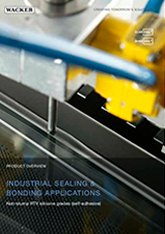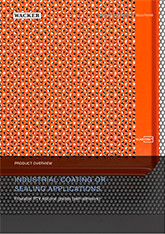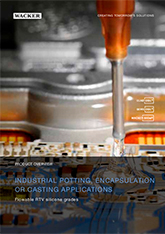Unser System hat erkannt, dass Sie aus USA kommen aber die aktuelle Ländereinstellung Dänemark ist. Wollen Sie dennoch Ihr Land ändern?
Papier & Verpackung

VINNAPAS® Polymerdispersionen werden bei der Formulierung einer breiten Palette an Papier- und Verpackungsklebstoffen verwendet. Sie sind für ihre starke Adhäsion auf einer Vielzahl von Substraten bekannt und zeichnen sich durch eine hervorragende Hitzebeständigkeit und maschinelle Verarbeitbarkeit sowie durch ihre vielseitigen Formulierungseigenschaften aus.
Die WACKER Technical Center bieten Testmöglichkeiten für unterschiedliche Formulierungen von Papier- und Verpackungsklebstoffen. Hier: Prüfung der Abbindegeschwindigkeit.
Product Recommendations
|
Products
|
Technical data
|
Product properties
|
Suitability
|
Paper & Packaging
|
|||||||||||
|---|---|---|---|---|---|---|---|---|---|---|---|---|---|---|---|
| Solids content | Viscosity, dynamic | Glass transition temperature | Adhesion & Strength | Sustainability Aspects |
Paper & Packaging
|
Tapes & Labels
|
Adhesion
|
Cleanability
|
Nozzle Application
|
Cohesion/ Heat Resistance
|
Roller/ Wheel Application
|
Setting Behavior
|
Water Resistance
|
||
| - - | - - | - - | - | - | - | - | - | - | - | - | - | - | - | ||
| 48 - 52 % 48 - 52 % | 30000 - 40000 mPa·s 30000 - 40000 mPa·s | ca. 33 °C[1] ca. 91,4 °F[1] | - | - | - | - | Medium | Excellent | Medium | Excellent | High | High | Medium | ||
| 53 - 57 % 53 - 57 % | 1500 - 4500 mPa·s 1500 - 4500 mPa·s | ca. 33 °C[2] ca. 91,4 °F[2] | - | - | - | - | Medium | Excellent | Medium | Excellent | High | High | Medium | ||
| 58 - 62 % 58 - 62 % | 29000 - 41000 mPa·s 29000 - 41000 mPa·s | ca. 33 °C[1] ca. 91,4 °F[1] | - | - | - | - | Medium | Excellent | Medium | Excellent | High | High | Medium | ||
| 44 - 48 % 44 - 48 % | 6000 - 14000 mPa·s 6000 - 14000 mPa·s | ca. 30 °C[1] ca. 86,0 °F[1] | - | - | - | - | Medium | High | Medium | Excellent | Medium | High | High | ||
| 58 - 62 % 58 - 62 % | 4500 - 9500 mPa·s 4500 - 9500 mPa·s | ca. -35 °C[3] ca. -31,0 °F[3] | - | - | Excellent | Medium | Medium | Medium | Medium | Medium | Medium | ||||
| 58 - 61 % 58 - 61 % | 4500 - 9500 mPa·s 4500 - 9500 mPa·s | ca. -35,0 °C[3] ca. -31 °F[3] | - | - | - | Excellent | Medium | Medium | Medium | Medium | Medium | Medium | |||
| 53 - 57 % 53 - 57 % | 1500 - 4500 mPa·s 1500 - 4500 mPa·s | ca. 33 °C[3] ca. 91,4 °F[3] | - | - | - | - | - | - | - | - | - | - | - | ||
| 56 - 58 % 56 - 58 % | 500 - 2500 mPa·s 500 - 2500 mPa·s | ca. -10 °C[1] ca. 14,0 °F[1] | - | - | - | - | High | Medium | Medium | Medium | Medium | Medium | Medium | ||
| 49 - 51 % 49 - 51 % | 6000 - 12000 mPa·s 6000 - 12000 mPa·s | ca. 1,0 °C[1] ca. 33,8 °F[1] | - | - | - | - | High | Excellent | Medium | High | Excellent | High | Excellent | ||
| 49 - 51 % 49 - 51 % | 4000 - 6000 mPa·s 4000 - 6000 mPa·s | ca. 3 °C[1] ca. 37,4 °F[1] | - | - | - | - | High | Excellent | Medium | High | Excellent | High | High | ||
| 54 - 56 % 54 - 56 % | 4000 - 7000 mPa·s 4000 - 7000 mPa·s | ca. 3 °C[1] ca. 37,4 °F[1] | - | - | - | - | High | Excellent | Medium | High | Excellent | High | High | ||
| 59 - 61 % 59 - 61 % | 2800 - 4800 mPa·s 2800 - 4800 mPa·s | ca. 3 °C[1] ca. 37,4 °F[1] | - | - | - | - | High | Medium | Medium | High | High | High | Medium | ||
| 56 - 58 % 56 - 58 % | 9000 - 15000 mPa·s 9000 - 15000 mPa·s | ca. 3 °C[1] ca. 37,4 °F[1] | - | - | - | - | High | Excellent | High | High | Excellent | High | High | ||
| 54 - 56 % 54 - 56 % | 2000 - 2800 mPa·s 2000 - 2800 mPa·s | ca. 5 °C[1] ca. 41,0 °F[1] | - | - | - | - | High | Excellent | High | High | Excellent | High | Medium | ||
| 54 - 56 % 54 - 56 % | 1700 - 3300 mPa·s 1700 - 3300 mPa·s | ca. -7,0 °C[1] ca. 19,4 °F[1] | - | - | - | - | Excellent | Excellent | Excellent | High | Excellent | Excellent | Medium | ||
| 53 - 57 % 53 - 57 % | 3000 - 5000 mPa·s 3000 - 5000 mPa·s | ca. 5 °C[1] ca. 41,0 °F[1] | - | - | - | - | High | Excellent | Excellent | High | Excellent | High | Medium | ||
| 58 - 61 % 58 - 61 % | 4000 - 8000 mPa·s 4000 - 8000 mPa·s | ca. -10 °C[1] ca. 14,0 °F[1] | Adhesion on critical surfaces, Excellent adhesion | Produced without APEO | - | - | - | - | - | - | - | - | - | ||
| 52 - 55 % 52 - 55 % | 5000 - 10000 mPa·s 5000 - 10000 mPa·s | ca. -8 °C[3] ca. 17,6 °F[3] | - | - | - | - | - | - | - | - | - | - | - | ||
| 54 - 58 % 54 - 58 % | 1000 - 4000 mPa·s 1000 - 4000 mPa·s | ca. 20 °C[1] ca. 68,0 °F[1] | - | - | - | - | Medium | Excellent | Medium | Excellent | Excellent | High | Medium | ||
[1] Glass transition temperature | specific method, [2] Glass transition temperature Tg DSC | DSC, specific method, [3] Glass transition temperature | DSC, specific method, [] Suited, [] Well suited, [] Ideally suited













